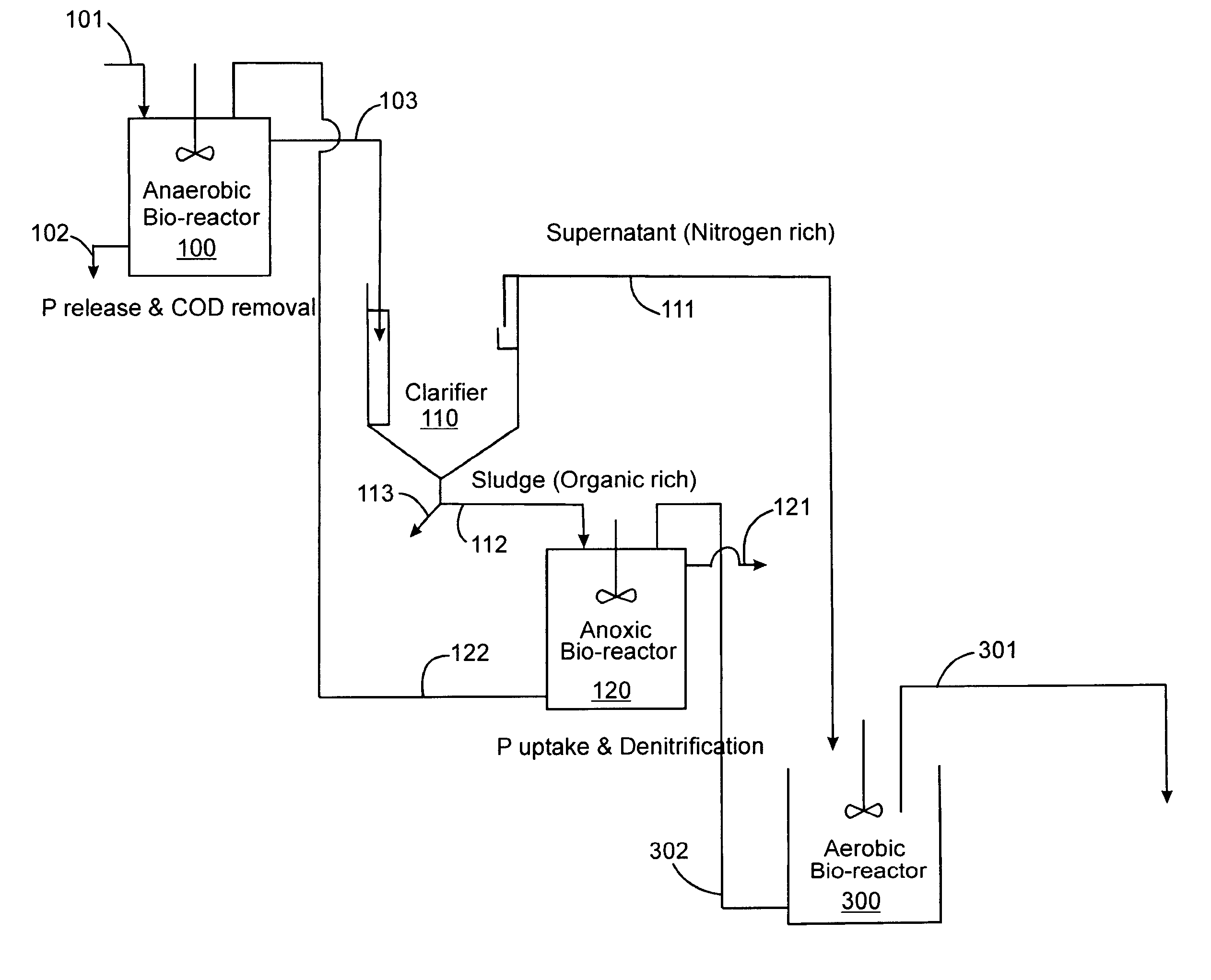Treatment of wastewater containing phosphorous and nitrogen
a technology of biological treatment and wastewater, applied in biological water/sewage treatment, sustainable biological treatment, membrane technology, etc., can solve the problems of limiting the overall rate of phosphorous removal in ebpr systems, and limiting the overall rate of n removal, so as to reduce the competition for organic carbon due to de-nitrification, increase the extent of p release, and increase the effect of p uptak
- Summary
- Abstract
- Description
- Claims
- Application Information
AI Technical Summary
Benefits of technology
Problems solved by technology
Method used
Image
Examples
example 1
[0051]An experimental system according to the fifth embodiment of the invention, shown in FIG. 5, was operated in the laboratory to obtain performance data. The experimental system consisted of anaerobic, anoxic and aerobic acrylic bio-reactors of 5, 5 and 10 L, respectively, and a clarifier made of clear PVC of 15 L volume (working volume 10 L). ZW-1 membranes (Zenon Environmental Systems Inc., Oakville, ON), with pore size of 0.04 μm and nominal membrane surface area of 0.047 m2, were immersed in the aerobic bio-reactor and used as a final separation unit. Air (2-4 L / min) was introduced at the bottom of the membrane modules and served two main purposes: supplying oxygen for the bio-reactor and creating turbulent flow around the membrane surface to reduce membrane fouling. Peristaltic pumps (Masterflex, Model 77521-40, 77200-12, 77200-60, IL, USA) were used to transfer wastewater from one unit to another and a vacuum pump was used to collect effluent from the membranes for storage ...
example 2
[0069]Observed system yields (Yobs), calculated from the slopes of cumulative VSS versus cumulative COD removed plots (not shown), were 0.28 gVSS / gCOD during SWW (R2=0.988) and 0.26 gVSS / gCOD during MWW (R2=0.996). However, these yields are based on total VSS measured and not on the mass of active biomass. Using the VSS / TSS ratio of 0.8 during SWW and 0.73 during MWW, yield based on TSS is 0.35 gTSS / gCOD for both SWW and MWW. At the operational SRT of 10 days, true yield is estimated at 0.42 gVSS / gCOD (SWW) and 0.39 gVSS / gCOD (MWW). The true yields were calculated using the typical decay coefficient (Kd) of 0.05 d−1. Table 4 presents the comparison of Yobs achieved in this study with other literature data. Upon comparison of the true yields (Ytrue) for the various systems listed in Table 4, it is evident that the true yields of this process agrees with that of Cicek et al. (1998), which discusses performance of a membrane bio-reactor system without biological nutrient removal, and i...
example 3
[0071]Table 5 presents a comparison of the performance of the present invention with other bio-P processes. Although specific examples have been selected for comparison, these processes are reported on throughout the scientific and patent literature and generally achieve comparable results to those reported herein. The processes selected for comparison include A2O (You et al., 2003), Dephanox1 (Bortone et al., 1996), Dephanox2 (Sorm et al., 1996), Johannesburg (JHB1) (Bortone et al., 1996), JHB2 (Burke et al., 1986), Phoredox (A / O) (Burke et al., 1986), Bardenpho (Burke et a., 1986), University of Cape Town (UCT) (Siebritz et al., 1983), Modified University of Cape Town (MUCT) (Siebritz et al., 1983), single stage MBR (Fan et al., 1996), and Sequencing Anoxic / anaerobic Membrane bioreactor (SAM) (Ahn et al., 2003). All of the above processes are laboratory scale except for single stage MBR, which is a pilot scale process. Most of these studies (except A2O and SAM) were operated on mu...
PUM
| Property | Measurement | Unit |
|---|---|---|
| pore sizes | aaaaa | aaaaa |
| pore sizes | aaaaa | aaaaa |
| volume | aaaaa | aaaaa |
Abstract
Description
Claims
Application Information
 Login to View More
Login to View More - R&D
- Intellectual Property
- Life Sciences
- Materials
- Tech Scout
- Unparalleled Data Quality
- Higher Quality Content
- 60% Fewer Hallucinations
Browse by: Latest US Patents, China's latest patents, Technical Efficacy Thesaurus, Application Domain, Technology Topic, Popular Technical Reports.
© 2025 PatSnap. All rights reserved.Legal|Privacy policy|Modern Slavery Act Transparency Statement|Sitemap|About US| Contact US: help@patsnap.com



